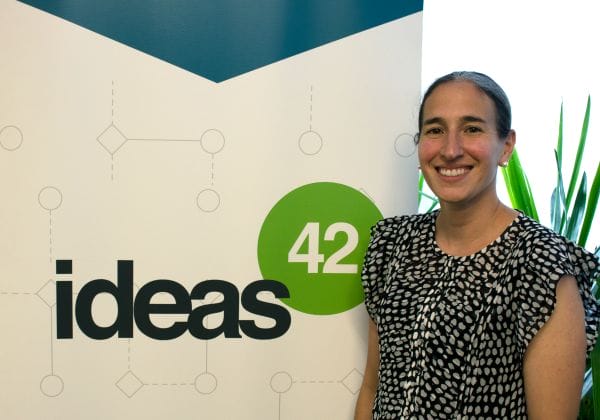With the ideas42 Seminar Series, we invite leading scholars to share their insights and what inspires their exploration into human behavior.
Our New York office was pleased to host Christina Roberto, an Assistant Professor of Medical Ethics & Health Policy at the Perelman School of Medicine at the University of Pennsylvania and the Director of the Psychology of Eating And Consumer Health (PEACH) lab. Her research aims to identify and understand factors that promote unhealthy eating behaviors linked to obesity and eating disorders and design interventions to promote healthy eating. She completed her undergraduate degree at Princeton University and earned a joint-PhD in clinical psychology and chronic disease epidemiology from Yale University. After giving a talk to the ideas42 team, Christina was kind enough to share some of her thoughts on behavioral science:
What drew you to behavioral economics?
I became very interested in psychology as an undergraduate at Princeton. I became particularly interested in understanding the causes and treatments of eating disorders, and so I worked in an eating disorders research clinic after graduation. It wasn’t until graduate school, when I began studying food policies to promote healthy eating, that I became excited about merging behavioral science insights with a public health perspective. I remember when my PhD mentor presented the famous organ donation default effect for the first time in a large lecture course and the entire room gasped. That result got me really excited about the potential of behavioral economics to inform public health.
What would you say is one of the most surprising discoveries about human behavior?
Most important findings in behavioral economics and psychology don’t seem surprising after they’ve been discovered. Once you see the data on default options, the results make a lot of sense. In my experience, findings that are very surprising – so surprising that they make for good headlines – often rest on flimsy evidence, and wouldn’t replicate if investigated more rigorously. Maybe the most surprising realization in the last few years is that you can’t just accept that a published finding is true; you have to make sure the study was properly powered, and that the researchers didn’t observe the key effect only after trying to run many different analyses.
In your breadth of work, tell us about one of your favorite projects related to driving healthy behavior change.
Rather than a favorite project, I have a favorite approach to asking research questions. We call it Strategic Science. Usually scientists generate research questions based on what they are interested in and curious about. That can lead to important discoveries, but it often means that scientists miss out on the opportunity to provide policymakers with the answers to their most pressing questions. Strategic Science is about asking questions that policymakers need answered. To do this, I reach out to change agents—people who make or influence policy—to get their input into the types of research questions I’m asking. I then try to answer those questions in a rigorous, unbiased way, and, if all goes according to plan, publish it in a peer-reviewed journal. But publishing is not the only objective, as I’m also committed to communicating that work back to the same change agents who helped to formulate my research questions. Using this approach, my research has informed the design of food policies like national requirements to post calorie labels on chain restaurant menus and Philadelphia’s sodium warning label requirement for chain restaurants.
What have you learned in applying behavioral insights that has changed the way you work?
I think it is important to have theories that inform our choice of interventions, but if you are doing applied work and trying to really move the needle on behavior change, I think it’s critical to test those theories in the context you’re working in. You can’t just assume that interventions that have been effective in some contexts, such as implementation intentions or social norms messaging, will work in a different context. I’ve also come to appreciate just how large our sample sizes need to be to detect most of the small effects we are interested in. This is especially important when doing policy-relevant work in which a true null effect is informative; if your study is underpowered, you won’t know if the policy doesn’t work or if it will exert a small, but meaningful effect.
How do you use behavioral insights in your daily life (or recommend that people use behavioral insights in their daily lives)?
Behavioral science has taught me that it’s easier to sustain healthy habits if there are simple and concrete steps I can take that are easy to remember. So I try to adhere to a few simple rules-of-thumb when it comes to eating decisions. For example, rather than try to count calories, which takes a lot of effort or follow a fad diet that would be hard to maintain over the long-term, I have guidelines like: don’t drink sugary drinks, avoid red meat, make sure to have fruits or vegetables as part of lunch and dinner, and eat whole grains often.



